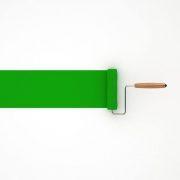How to Create a Woodgrain Finish on White Paint
Projects creating faux finishes are usually fun, but sometimes can become a challenge. The key to achieving quality work is to be bold enough to try to create it yourself. When it comes to reproducing the grain of wood, it is best to apply all the colors in a single layer. In this way, the colors are mixed effectively, creating the sensation of watching the layers that make up real wood. To achieve the desired effect, begin working with a sample of authentic wood as a guide. Surely you can find excellent examples of various types of grain in samples you would get to pick out wood stain. If you want to reproduce the grain of the wood on a layer of white paint, choose a sample of bleached oak or pine.
Instructions
- Prepare a test piece by applying a layer of the same color of the surface and a translucent white paint using a piece of material similar to what you will cover with the finish. You can use a wooden board 12 inches (30 cm) long and at least six inches (15 cm) wide. Apply the paint with a brush using long, straight strokes along the grain. Let dry completely.
- Pour a small amount of white paint, light gray and black on a tray. Preferably use semi-gloss latex paints for interiors. Such formulas better adhere to most surfaces and are easy to work and clean, plus they do not emit toxic gases.
- Dip the end of a soft-bristled brush tip “sash” type of 1/2 inch (1.2 cm) in diameter, in a bucket or pail of water. Drag the bristles through the edge of the container to squeeze the water until it stops dripping. Load the brush to about one inch (2.5 cm) from the tip end with white paint. Submerge only the end in the gray paint and only the tip of the brush in the black color.
- Work in long, straight movements when applying paint to the surface, pressing the brush slightly to make the stroke of the three colors. Drag the brush back along the same path, so you paint back and forth. Applying paint in sections, one at a time, more or less the size of your test piece.
- Retrace the section, adding the colors that are not as pronounced. Gray and black should be seen as blurred streaks or lines. Check your wood sample to see if you combine and experiment more with the mixture to obtain a design that you’re happy with.
- Use a fine artist brush to paint the lines of the grain with gray and some black. Mimic the lines in the wood sample you have chosen and add some curves. Create areas where the vein becomes darker and add a thin white line along the edge to highlight it. This will help you create an effect of depth and shading.
- Go over the dry surface from front to back, with a clean brush. You can rinse the brush tip and use it in this step or work with a wider one. This improves the effect of the grain and mixed hues not too different remaining together. The aim is to give the impression of natural wood without knowing it’s actually is a paint job.
- Continue to improve the grain, giving reflections on the surface, always trying to work in the right direction. If you’re going to paint a piece of furniture or a detail like molding, make sure the lines are alternated in the same way as they would on a piece of real wood. For example, if the lines of the grain in an authentic piece or your sample have an angle of 90 degrees in a corner, try to paint the piece perpendicular to piece painted earlier.






